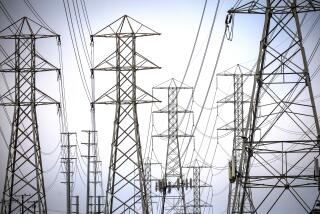Ratepayers Forgotten in Case of Bankruptcy
At the epicenter of the power crisis gripping California, the state’s two largest utilities--Southern California Edison and Pacific Gas & Electric Co.--have threatened that unless they can double their rates and pass on record wholesale power costs to consumers, they will seek remedies under U.S. bankruptcy laws.
The California Public Utilities Commission has offered interim rate relief but bond-rating agencies and the banking community are not yet fully satisfied that the financial health of both companies will be restored. Gov. Gray Davis, the state Legislature and others are now urgently deliberating various options to avert a meltdown. Under the Davis plan, the state would sell energy at cost to Edison and PG&E.; They, in turn, would bill their customers at rates set by the Public Utilities Commission.
Increasingly, ratepayers and constituents ask why the state should help out these companies, expressing exasperation that they again should be required to possibly absorb the cost of others’ market misjudgments.
How to solve the crisis poses a question worthy of debate. But no one should be deluded into concluding that any satisfactory, politically forged outcome should embrace a bankruptcy option.
As a former utility regulator in Texas, I saw firsthand the most recent bankruptcy of an investor-owned utility in the United States--that of the El Paso Electric Co. in the early 1990s. The experience taught me and others involved that a utility bankruptcy causes an already difficult situation to become even more complicated. If either PG&E; or Edison goes bankrupt, the California PUC--not to mention the governor and Legislature--would suddenly inherit a new, assertive partner: bankruptcy court.
Once the bankruptcy case commences, the court would take charge. Following federal law, its aim would be to preserve the financial viability of the utility to maximize its estate value to satisfy creditors’ claims and minimize losses to shareholders. If this looks like a shutout of ratepayers, that’s the point. In fact, the bankruptcy court places the ratepayers’ interest below that of creditors and shareholders.
In Texas, the utility commission was often troubled by that stance. But that’s the way the bankruptcy law is written, and we could do little more as a state agency than remind the court that Texas law obligated us to look after ratepayers as well. While a bankruptcy remains pending, the court bears no obligation to defer to the wishes of any state agency or executive, including the governor or state legislature, except when the court itself wants to maintain a cordial relationship with them as parties to the case before it. More unsettling, it is highly possible that any legislatively negotiated solution to the current crisis would not be the final word. Rather, it is plausible that the bankruptcy court’s ratification would be required.
Would a rate increase be needed to get the utility out of bankruptcy? It depends. The court will first ask whether other relief measures are available, such as shedding costly obligations and selling off marketable assets. If all alternatives are exhausted, the court could approve a relief plan that includes a rate increase because ratepayers are viewed as a captive, revenue-raising resource. If it finds a rate increase is required, bankruptcy law calls for the court to order the utility to get the PUC’s approval. If the commission agrees, that’s it. But if it doesn’t, the question of whether the court can override the PUC is raised. Some experts argue that the court’s federal supremacy can trump the state.
In the El Paso case, some parties wanted the court to order higher rates regardless of whether state regulators agreed. Before that occurred, the parties reached a settlement that called for adoption of higher interim rates that became permanent for a 10-year period. The Texas PUC and the court ultimately approved the increase. So we never confronted the thorny question of who wins in a fight between the state and the court. Arguments urging federal preemption can go beyond rate increases. It’s not a far stretch for a party in the bankruptcy case to ask that the court preempt the state to prevent it from taking unilateral action in the best interest of all constituents. Or a party could ask the court to order the state to seek the court’s blessing for any negotiated solution.
The court’s legal obligation is not to balance the states’ diverse political interests, but rather to achieve an outcome best favoring the interests of the bankrupt company, its creditors and its shareholders. If ratepayers genuinely desire a politically accountable solution, the best forum would not be bankruptcy court but the PUC or a gubernatorial and legislatively crafted process.
As we learned in Texas, bankruptcy doesn’t prevent rate increases. It meant state regulators had to fight harder to protect ratepayers outside our own turf.
More to Read
Inside the business of entertainment
The Wide Shot brings you news, analysis and insights on everything from streaming wars to production — and what it all means for the future.
You may occasionally receive promotional content from the Los Angeles Times.










